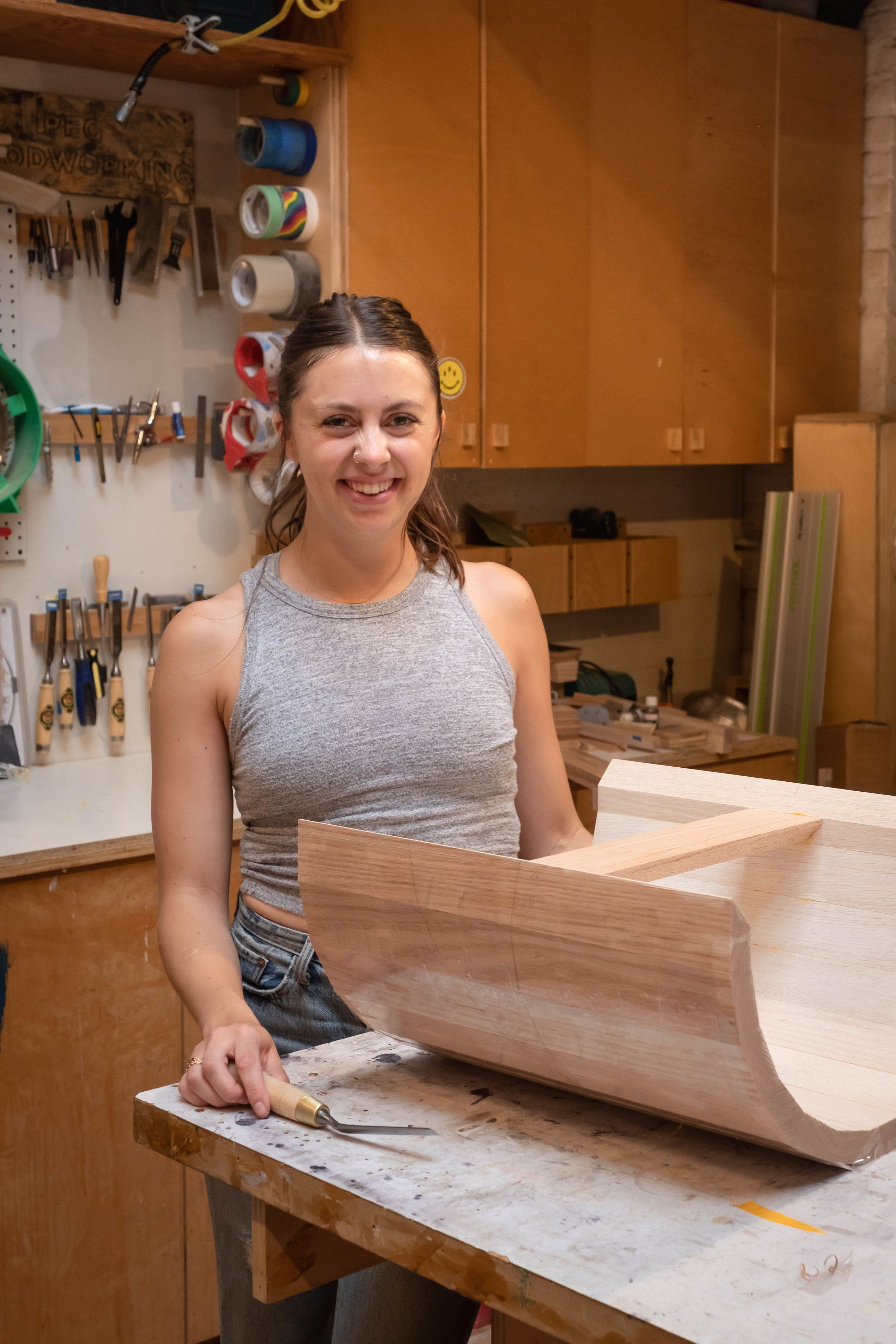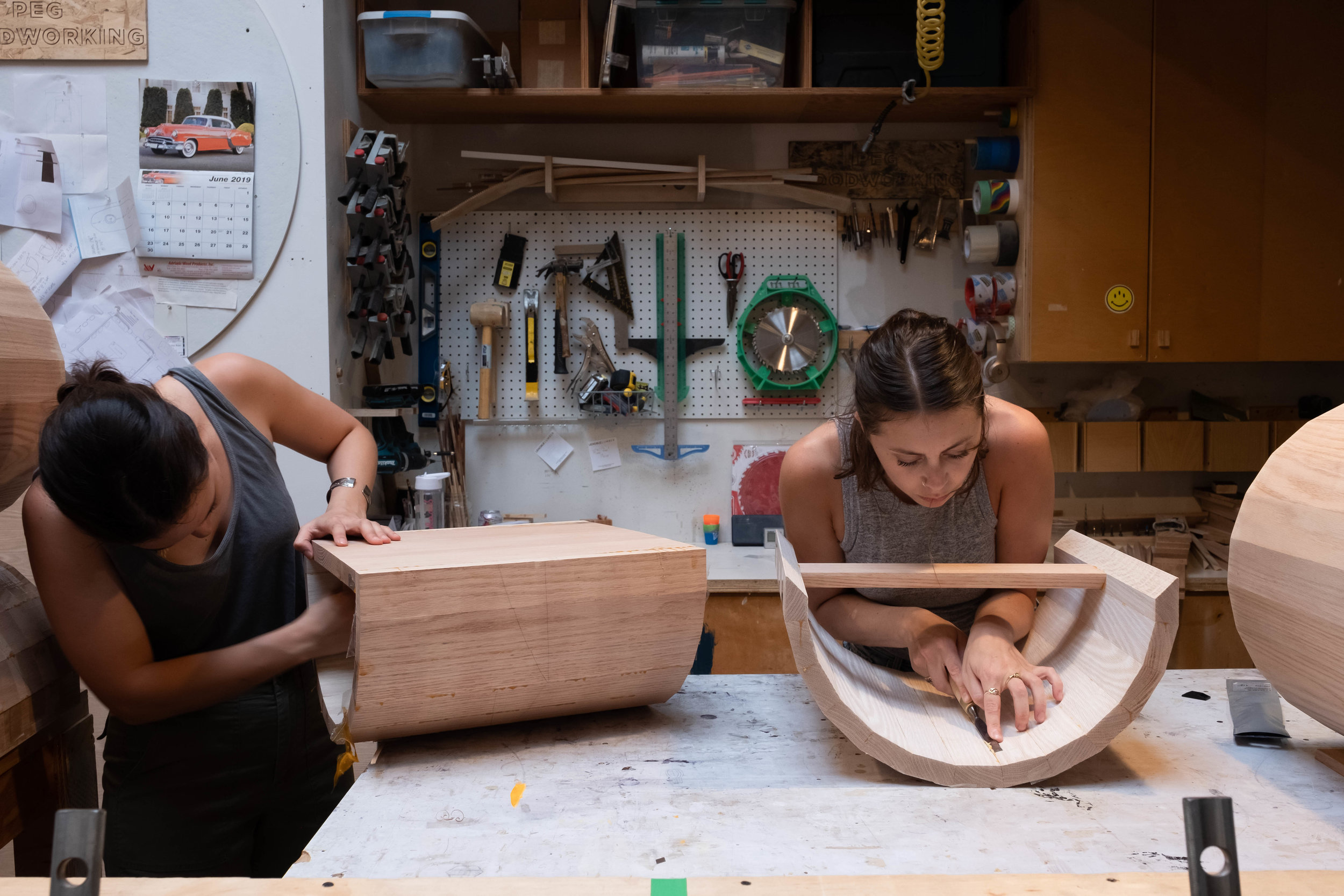Where Women Work | Kate Casey of Peg Woodworking
Editor’s Note: We are thrilled to kick-off a new series today called ‘Where Women Work.’ At ROSE & IVY, we are very lucky that we get to cross paths with many talented individuals who have fascinating careers. Many of them have made us curious and made us ask—how do you break into something like that? We took that notion and decided to find out. In this series, we will explore a range of creative fields and tap into those who are pursuing certain paths by asking how they did it, what they have learned and advice on how to break into various fields. We hope this column leaves you inspired!
Brooklyn-based woodworker Kate Casey of Peg Woodworking is what you would call an anomaly in her field. Even though her industry is primarily dominated by men, this hasn’t stopped her from making a name for herself in the design world. We discovered her work while perusing the Architectural Digest Show last year and were immediately transfixed by her sculptural wood pieces and detailed woven patterns that are transposed onto chairs, stools and benches. We were excited to include the company’s totems in our cover shoot with Julia Stiles. We stepped into the Peg Woodworking world to find Kate and her two assistants, Sally and Catherine, hard at work polishing, sanding and creating at their studio in Bed-Stuy, Brooklyn. We also explored their design studio in Fort Greene. We were fascinated by the process and how you will be too.
Meet Kate Casey
Founder of Peg Woodworking
Follow Peg Woodworking on Instagram
Official Job Title
I have Principal written on my business cards because I feel like it’s all encompassing. It’s also much more concise than 'Founder, Woodworker, Designer' but I feel like designer is the most appropriate, as I occasionally stray from wood as a material to incorporate stone, metal or glass.
Kate carefully removing the glue from one of the structural pieces.
Kate weaving a bench at her design studio in Brooklyn.
You’re at a cocktail party and someone asks what you do. What’s your answer?
I think I would start with woodworker in that case, it's a more recognizable occupation that people tend to have more of a connection too, whether through a family member or a part-time hobby. I feel like telling people I'm a woodworker in a social setting opens the door to a lot of interesting side conversations especially being that I am a female in a predominately male field.
Scraps of wood and supplies at the ready.
What drew you to woodworking and was this your first job/career?
I was first drawn to woodworking as a need. I had just moved into what I felt was my first 'adult' apartment and I didn't want to outfit it with exclusively IKEA. Having a background in sculpture and fabrication I knew I had the skill set to make furniture, I just had to make that initial step. I was working as an assistant to sculptor Matthew Day Jackson at the time and would bring half-finished pieces to his studio to work on and get advice from the rest of the crew. By the end of it, I was completely in love with the process and so excited to be able to use what I had made every day. It was at that point that I switched gears from purely sculpture to functional sculpture. I went back to school for woodworking at the Center for Furniture Craftsmanship to learn the proper techniques, so I could go forward with confidence that what I was creating was properly built.
Team work—Kate works alongside her coworker Sally.
Sally is removing the glue that bonds the pieces together.
How did you go about starting your company?
After woodworking school, I worked for a few months as a freelance woodworker, while making as much new work as I could in my free time. I didn't have much of a wood shop at that point so I was using a lot of hand tools and making smaller pieces that could fit within my space limitations. I slowly started to build a brand primarily around a wood bending technique called coopering, along side hand woven seating. I would do some smaller trade shows presenting the few pieces I had that I felt confidant about and eventually people started to notice. Over the past few years, my furniture has matured into a body of work I am really proud of but those early designs are still a part of my collection to show my evolution and path as a designer.
(from left) Catherine, Kate and Sally discussing a custom console table.
What’s usually the first thing you do when you get into the office in the morning?
Well, the nice thing about my studio practice now is that I have two amazing assistants who help me handle the sometimes overwhelming work load—Sally Suzuki is my Studio Manager and Catherine Woodard handles client outreach, as well as assisting in fabrication. So usually the first thing we do is meet and asses the hierarchy of the days tasks. Some days the inbox is busy some days weaving needs to be done and some days are spent in the shop. The nice thing about our team is that we are fairly interchangeable and far as day to day tasks. I am the head woodworker but both girls know the weaving, administrative, and finished work, this makes it easy for us to switch gears if one of us is busy.
What role do you play, e.g. what’s a typical day look like for you, since you oversee everything?
I wake up and answer urgent emails and handle social media posts in bed. My assistants and I meet. If it’s a weaving day, we work from my home studio. If it’s a shop day, we hop from project to project, which are all at different stages. Most days there are chair frames to bring to the powder coater or marble that needs to be picked up. It can get a little chaotic; I am getting better at streamlining and delegating so I don't have to be spread so thin.
The workshop in Bed-Stuy, Brooklyn.
What would you say is one misconception about your job?
I think people underplay the speed and cost at which custom furniture can be made. Being in NYC, specifically Brooklyn, places us in a creative hub that can be very exciting even though it is one of the most expensive cities in the world to live in. Affordable fabrication and manufacturing in Brooklyn is getting harder and harder to find while the cost of work spaces skyrocket. We pride ourselves on making our work entirely in New York giving jobs to local metal workers and stone cutters but it comes at a steep cost. I think it is commonly misunderstood that each step of the process requires a trained artisan to hand make certain components of a piece, which is both costly and time consuming. The end result is a piece of furniture that has been handmade and cared for at every step; it is a source of pride for us and I think that comes across in the finished product.
The sanding machine polishing the wood.
Kate trimming a piece of wood.
How do you navigate the highs and lows of running your business?
Carefully. I am not trained to run a small business, I am a graduate of Massachusetts College of Art, which provided me with an understanding of concept and form but not a firm foundation for entrepreneurship. This led me to seek out help in this field because I tend to avoid aspects of my business that I do not feel confidant in, which I knew would stunt growth. I went back to school this year to take a small business class offered by the SBIDC, which covered accounting to marketing and goal planning, filling in these gaps in my knowledge gave me much more confidence at approaching day to day issues in my business. I am also learning to give myself a bit more credit when its due. I am definitely my harshest critic and that has served me well, when I was getting started—pushing myself to make goals and working through difficult times, but I need to take pride in the successes and not just criticize the failures, which is a slow process, but I'm getting there.
Kate removing the table and glue from the inside of a totem.
What is the most valuable career advice you have ever been given?
My mom tells me all the time to 'stay present’—it’s a simple concept that I find very hard to practice. I have a tendency to always look for the next big thing, to look to the future for potential successes rather than credit myself for current ones. I think this weighs on my self-esteem because things are never quite good enough. My goal for the next year or so is to appreciate what I have made for myself currently while still maintaining a healthy drive and ambition.
Have you had a mentor to look up to to help you navigate your industry?
I have people who I admire in my field but because everyone’s practice and path is so individual I haven't had a consistent mentor. Although the lack of an actual mentor has been made up for with the hiring of my two assistants. They have been there for most of the difficult decisions and the choices that will change the companies direction, they act as both consultants and friends and I would be lost without them.
The pièce de résistance, a side table.
Colorful cording to be used on chairs and tables.
What’s your advice to those looking to have a successful career in design?
I would say curiosity has served me the best. Both materially and with actual design. Sticking within a comfort zone does not expand your skill set and I adamantly believe that acting on your curiosity will push yourself to an impressive and weird place.
The team in the Peg Woodworking Design Studio—Sally, Kate and Catherine.



















